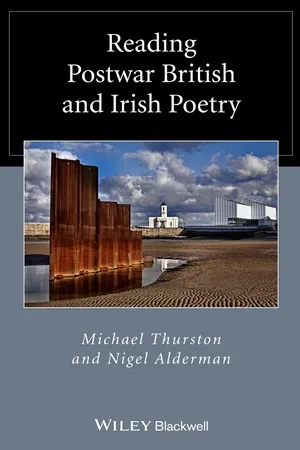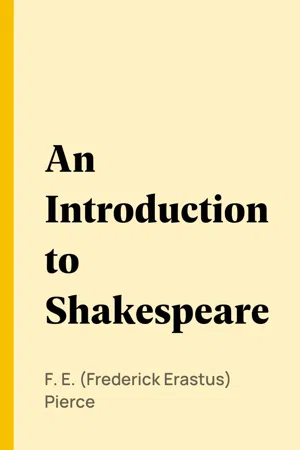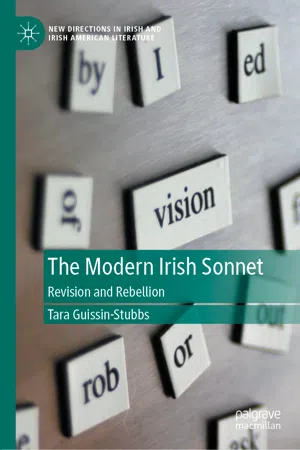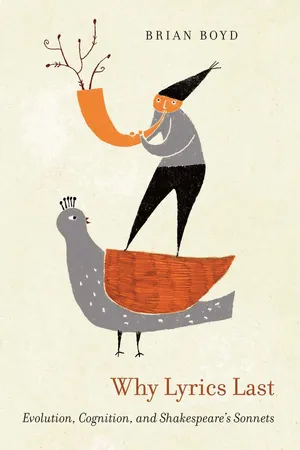Literature
Shakespearean Sonnet
A Shakespearean sonnet is a 14-line poem written in iambic pentameter with a specific rhyme scheme. It is divided into three quatrains and a final couplet, with the rhyme scheme abab cdcd efef gg. The sonnet often explores themes of love, beauty, and the passage of time, and is known for its structured form and emotional depth.
Written by Perlego with AI-assistance
6 Key excerpts on "Shakespearean Sonnet"
- eBook - ePub
- Michael Thurston, Nigel Alderman(Authors)
- 2013(Publication Date)
- Wiley-Blackwell(Publisher)
Again form reinforces content: the final line lists the exception and enacts this by being itself the only exception. Clearly, for Shakespeare and his fellow sonneteers, the English sonnet became an increasingly complex form that lent itself to analyzing emotional states through the structure of logic and argument. In the next stage in the history of the English sonnet, the poets who immediately follow Shakespeare use the form to investigate the inner turmoil of the religious self and transfer the language of pained sexual love into tortured plaints of divine love: John Donne, for example, urges Christ to “ravish” him. Donne adapts the Shakespearean Sonnet by returning to the Petrarchan octave (abbaabba) followed by a sestet made up of the Shakespearean final quatrain and concluding couplet (cdcd ee). This form becomes especially effective when the constricted rhyme of the octave reinforces a sense of spiritual impasse that is released by the sestet and that culminates in an acceptance of God’s will in the couplet. John Milton extends the sonnet into political subject matter, and although he returns to the Petrarchan rhyme form, he works his syntax over and beyond the structural endings suggested by the rhyme and often places the turn in the middle of lines or in lines in the middle of the rhyme scheme. Indeed for the Romantic poets, David Fairer argues, Shakespeare and Milton represent two contrasting thematic positions for the sonnet – poems of intense interiority and poems of public politics. Characteristically, Romantic sonnets often combine these positions by enacting an argument between political engagement and poetic retreat (2005: 301). As this brief history shows any poet who decides to write a sonnet cannot help but enter this rich and complex tradition, and readers, similarly, need to be aware of and concerned with such formal traditions - eBook - ePub
- F. E. (Frederick Erastus) Pierce(Author)
- 2010(Publication Date)
- Perlego(Publisher)
Such popularity for any particular type of literature never arises without a reason. The aim of the sonnet is to embody one single idea or emotion, one deep thought or wave of strong feeling, to concentrate the reader's whole mind on this one central idea, and to clinch it at the end by some epigrammatic phrase which will fasten it firmly in the reader's memory. For instance, in Milton's sonnet On his Blindness, the central idea is the glory of patience; and the last line drives this main idea home in words so pithily adapted that they have become almost proverbial. During the sixteenth century, rich young Englishmen were in the habit of traveling in Italy for education and general culture. They brought home with them a great deal that they saw in this brilliant and highly educated country; and among other things they imported into England the Italian habit of writing sonnets. The first men who composed sonnets in English after the Italian models were two young noblemen, Sir Thomas Wyatt and the Earl of Surrey, who wrote just before Shakespeare was born. Their work called out a crowd of imitators; and in a few years the writing of sonnets became the fashion. As a young man, Shakespeare found himself among a crowd of authors, with whom sonnetteering was a literary craze; and it is not surprising that he should follow the fashion. Most of these were probably composed about 1594, when the poet was thirty years old; but in regard to this there is some uncertainty. A few were certainly later. They were not printed in a complete volume until 1609;[ 6 ] and then they were issued by a piratical publisher, apparently without the author's consent. In the Shakespearean Sonnet the complicated rime scheme of its Italian original has become very much simplified, being reduced to the following form: a, b, a, b; c, d, c, d ; e, f, e, f ; g, g. This is merely three four-line stanzas with alternate rimes, plus a final couplet - eBook - ePub
Teaching Poetry
Reading and responding to poetry in the secondary classroom
- Amanda Naylor, Audrey Wood(Authors)
- 2012(Publication Date)
- Routledge(Publisher)
The voice here is of a woman who has experienced many lovers, who has made her own choices about who to love and when. Although there is much pain here, it is the expression of female sexuality that has had some self-determination. The Petrarchan structure is clear; the octave explores the persona’s previous loves, and the sestet revolves around the single image of the ‘lonely tree’, the remainder of the experience metaphorised as a tree abandoned by birds now that winter has come. There is much here that can be explored with a receptive GCSE group, and most certainly KS5 students. Millay wrote sonnet sequences and used the mode to explore female desire. She utilised the traditional poetic form of the sonnet, including the conventional use of pentameter, yet the voice and experience she represented challenges the accepted male orthodoxy of the form.The other most influential form of the sonnet is the Shakespearean Sonnet. Shakespeare wrote a sequence of 154 sonnets, all exploring love, some for a ‘dark lady’ and some for a young man. There is much that can appeal to KS3 and KS4 pupils in this sequence. Shakespeare plays with the Petrarchan form; he used fourteen lines, but reorganises the rhyme scheme into three quatrains of four lines (ABAB CDCD EFEF) and finishes with a couplet. The shape then requires more rhyming endings, and suggests that there will be three ideas, related in some way, with a neat ending with a rhyming couplet. Shakespeare can be seen subverting conventional depictions of the courtly lover in the famous Sonnet 130, where he works through a series of negatives of the features that his lover does not have, her hair is ‘black wires’ and her breath ‘reeks’. The relationship between the form of the sonnet, the lover’s features, and the content, the play with conventional depictions of love, offer much to explore within the classroom. Poems from the Past, by Mary Berry and Alex Madina (Berry and Madina 1997), contains a very wide selection of activities that can be undertaken with pre-twentieth-century poems. Their approach is very much one of using drama and active re-presentation of texts to make the poetry come alive for pupils. For Sonnet 130 they suggest miming and performing tableaux for the different aspects presented of the lady in the sonnet. This activity could feed directly into a discussion of form, as the tableaux would be, in effect, the content of the different quatrains. Another very useful text for ideas regarding specifically the writing of poems is Jumpstart: Poetry in the Secondary School - eBook - ePub
Becoming Poetry
Poets and Their Methods
- Jay Rogoff(Author)
- 2023(Publication Date)
- LSU Press(Publisher)
Although strict construction marks both traditional sonnet forms, the larger space of the Italian sonnet’s units, as well as the rhyme scheme’s greater freedom in its sestet, makes the form’s dictation of feeling less obvious and gives the Italian form the illusion of greater spontaneity. All the more reason, then, that Shakespeare’s accomplishment fills us with awe. Helen Vendler’s new book, The Art of Shakespeare’s Sonnets, nine years in the making, arrives as a commentary on our chief poetic god from the critic most often dubbed our god of interpretation. In fact, the book itself comically played a sort of savior when it made its stage debut at the age of three months in John Guare’s The General of Hot Desire, far and away the best of seven commissioned short plays inspired by Shakespeare sonnets, produced under the collective title Love’s Fire. In Guare’s play, a theatrical company assigned to create a play out of the Cupid sonnets, 153 and 154 (Guare’s own task, of course), encounters frustration after frustration in puzzling out the poems, until one actress arrives with a copy of Vendler’s book: “Helen Vendler!” they cry, as they begin to read her commentary; “I love Helen Vendler!” 4 The Art of Shakespeare’s Sonnets does give us much reason to love Helen Vendler, particularly if we revere the Sonnets as living, breathing poems, rather than as skeleton keys to Shakespeare’s life, sexuality, and personal attitudes, or to the secret identity of the young man, the rival poet, the dark lady, or Mr. W. H. Vendler undertakes to show the Sonnets in their considerable, if not infinite, variety, keeping in sight at all times the continual turns of thought and feeling in each poem that make it “a system in motion” and “a trajectory of changing feelings,” and “trying to see the chief aesthetic ‘game’ being played in each sonnet” (22–23) - eBook - ePub
The Modern Irish Sonnet
Revision and Rebellion
- Tara Guissin-Stubbs(Author)
- 2020(Publication Date)
- Palgrave Macmillan(Publisher)
sonnet which is the legitimate form, for it alone recognizes that peculiar imbalance of parts which is its salient characteristic’; however, the English sonnet ‘does something rather different with the form which is not quite as interesting or as subtle’, while ‘[c]ertain other freak varieties […] pay tribute only to the powerful echoes of the form that perversions of it essentially deny’.According to Fuller’s definition of the sonnet, most of the poems discussed in the present study would likely be dismissed as examples of what he terms either ‘strokes of brilliant licence’ or ‘the drudgery of persistent misunderstanding’.3 Fuller also refers the reader to Ezra Pound who, writing in an essay first published in 1934, claims that the sonnet ‘marks an ending or at least a decline of metric invention’, and ‘the beginning of the divorce of words and music’; in Pound’s mind, ‘by A.D. 1290 the sonnet is already ceasing to be lyric, it is already the epistle without a tune’.4 Yet it is the written features of such an ‘epistle’ that continue to hold an appeal, both in relation and in contradistinction to its oral potential. Paul Oppenheimer suggests that the sonnet was not intended to be spoken at all, claiming that ‘it is the first lyric form since the fall of the Roman Empire intended for silent reading’ and is ‘the first lyric of self-consciousness, or of the self in conflict’.5 We might also think of Helen Vendler’s response to Yeats’s use of the sonnet, where she suggests that what the form ‘meant to Yeats , historically speaking, was verse consciously aware of itself as written not oral’; this, when combined with its associations with the English lyric, ‘compelled from Yeats both his literary allegiance and his nationalist disobedience’.6 To read the sonnet form as Pound - eBook - ePub
- Brian Boyd(Author)
- 2012(Publication Date)
- Harvard University Press(Publisher)
Shake-speares Sonnets, 1609Passage contains an image 8 Lyric and Narrative Eliminating Story
Most lyric poems incorporate—how could they not?—elements of human experience also found in narrative: situations, attitudes, emotions, memories, propositions, settings, characters. Some lyrics may also include simple events—like Wordsworth’s sighting “a host of golden daffodils” in “I wandered lonely as a cloud”—usually as subjects for reflection rather than as part of a sequence of events. To the degree that poems incorporate the singular sequences of events characteristic of story, and depend for their impact on these sequences, we regard them as verse narratives rather than lyrics.In his sonnets Shakespeare avoids narrative and drama, even as he exploits to the utmost the resources of lyrics, individually and in sequence, including the resources that tap, in especially charged ways, into the emotional power that both narrative and drama draw on. While he keeps his lyrics free of narrative he takes full advantage of the intensity of emotional engagement allowed by two love relationships—one more, indeed, than in other Elizabethan sonnet sequences. His focus on love, standard in sonnet sequences, and his cast of defined characters, loving Poet, beloved and idealized Fair Youth, and desired but demonized Mistress, lay the basis for the passionate feeling and thought that he maximizes throughout the sequence. The sustained focus on first the Youth then the Mistress also reduces the costs for us as readers: although Shakespeare may surprise us with shifts in emotion, ideas, and strategies from sonnet to sonnet, we do not have to grope anew for the subject as we do in a collection of a poet’s unrelated lyrics. Wordsworth describes this effect well, in introducing his own Ecclesiastical Sonnets (1822): “For the convenience of passing from one point of the subject to another without shocks of abruptness, this work has taken the shape of a series of Sonnets.”1
Index pages curate the most relevant extracts from our library of academic textbooks. They’ve been created using an in-house natural language model (NLM), each adding context and meaning to key research topics.
Explore more topic indexes
Explore more topic indexes
1 of 6
Explore more topic indexes
1 of 4





